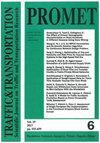北京地铁系统节点中心性差异的加权复杂网络分析
IF 1.1
4区 工程技术
Q4 TRANSPORTATION SCIENCE & TECHNOLOGY
引用次数: 0
摘要
车站的中心性是城市交通系统中最重要的问题之一。这种网络的中心站通常使用网络到网络的中心性度量来确定。在真实的网络中,客流产生于个人动态运动和底层物理结构之间的相互作用。本文采用双层模型对北京地铁系统中最中心的车站进行了识别,其中下层是实体基础设施,上层是客流。我们比较了两层模型的各种中心性指标,如程度、强度和中间中心性。为了表示车站外生因素对地铁系统的影响,我们引用了al-pha中心性。结果表明,地理系统中心站的中间度与网络中心站的α中心性不一致。我们通过将两种中心性度量与实际负荷进行比较来澄清这一差异,表明α中心性比中间度更接近实际负荷,因为它可以捕获沿链路以及进出系统的流量的方向和体积。实证研究结果可以为地铁系统的节点中心性提供一些有用的见解。本文章由计算机程序翻译,如有差异,请以英文原文为准。
Weighted Complex Network Analysis of the Difference Between Nodal Centralities of the Beijing Subway System
The centrality of stations is one of the most important issues in urban transit systems. The central stations of such networks have often been identified using network to-pological centrality measures. In real networks, passenger flows arise from an interplay between the dynamics of the individual person movements and the underlying physical structure. In this paper, we apply a two-layered model to identify the most central stations in the Beijing Subway System, in which the lower layer is the physical infrastruc-ture and the upper layer represents the passenger flows. We compare various centrality indicators such as degree, strength and betweenness centrality for the two-layered model. To represent the influence of exogenous factors of stations on the subway system, we reference the al-pha centrality. The results show that the central stations in the geographic system in terms of the betweenness are not consistent with the central stations in the network of the flows in terms of the alpha centrality. We clarify this difference by comparing the two centrality measures with the real load, indicating that the alpha centrality approx-imates the real load better than the betweenness, as it can capture the direction and volume of the flows along links and the flows into and out of the systems. The empirical findings can give us some useful insights into the node cen-trality of subway systems.
求助全文
通过发布文献求助,成功后即可免费获取论文全文。
去求助
来源期刊

Promet-Traffic & Transportation
工程技术-运输科技
CiteScore
1.90
自引率
20.00%
发文量
62
审稿时长
3 months
期刊介绍:
This scientific journal publishes scientific papers in the area of technical sciences, field of transport and traffic technology.
The basic guidelines of the journal, which support the mission - promotion of transport science, are: relevancy of published papers and reviewer competency, established identity in the print and publishing profile, as well as other formal and informal details. The journal organisation consists of the Editorial Board, Editors, Reviewer Selection Committee and the Scientific Advisory Committee.
The received papers are subject to peer review in accordance with the recommendations for international scientific journals.
The papers published in the journal are placed in sections which explain their focus in more detail. The sections are: transportation economy, information and communication technology, intelligent transport systems, human-transport interaction, intermodal transport, education in traffic and transport, traffic planning, traffic and environment (ecology), traffic on motorways, traffic in the cities, transport and sustainable development, traffic and space, traffic infrastructure, traffic policy, transport engineering, transport law, safety and security in traffic, transport logistics, transport technology, transport telematics, internal transport, traffic management, science in traffic and transport, traffic engineering, transport in emergency situations, swarm intelligence in transportation engineering.
The Journal also publishes information not subject to review, and classified under the following headings: book and other reviews, symposia, conferences and exhibitions, scientific cooperation, anniversaries, portraits, bibliographies, publisher information, news, etc.
 求助内容:
求助内容: 应助结果提醒方式:
应助结果提醒方式:


